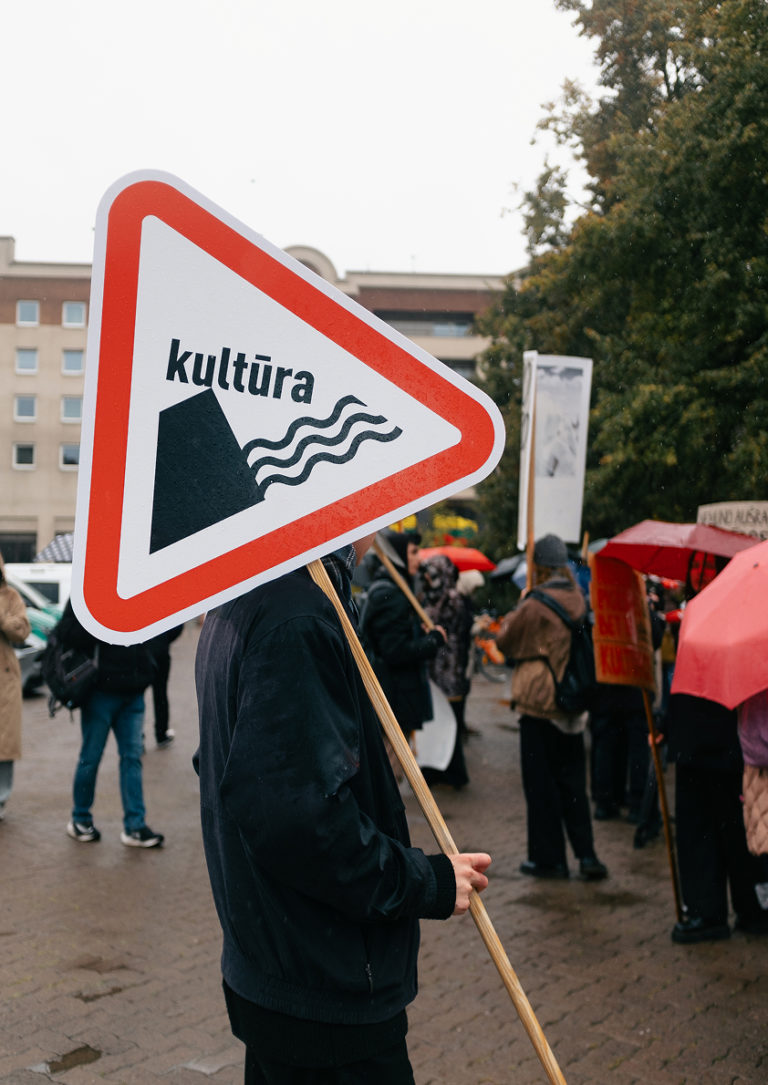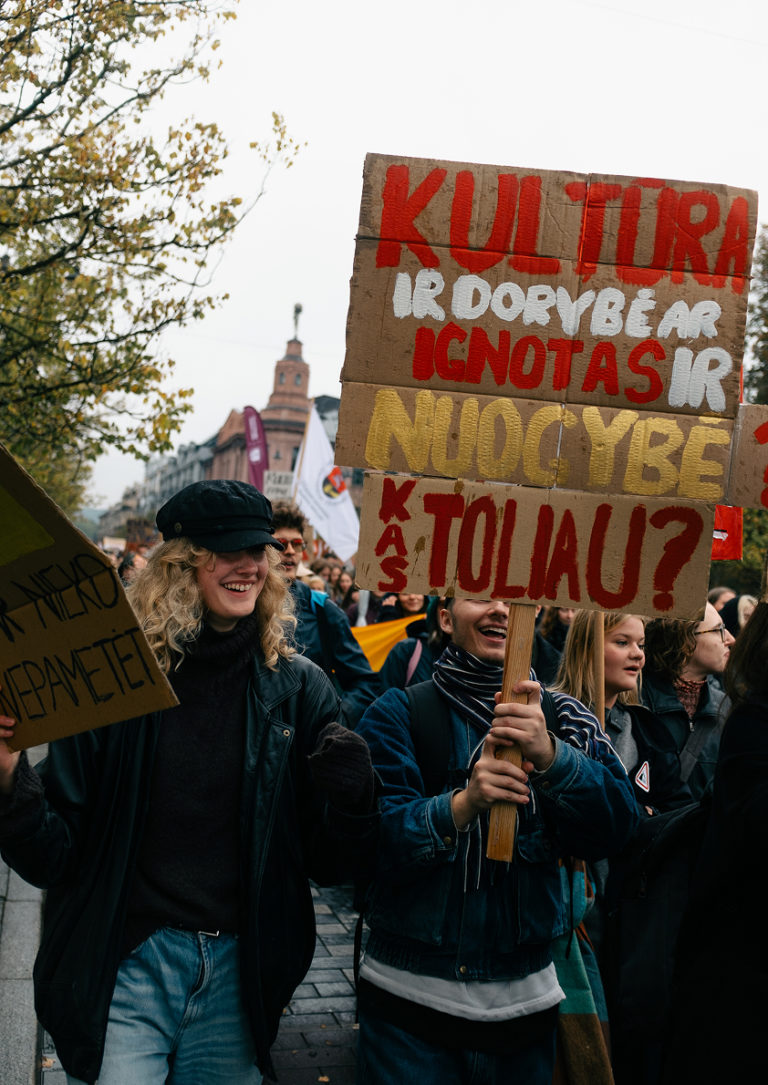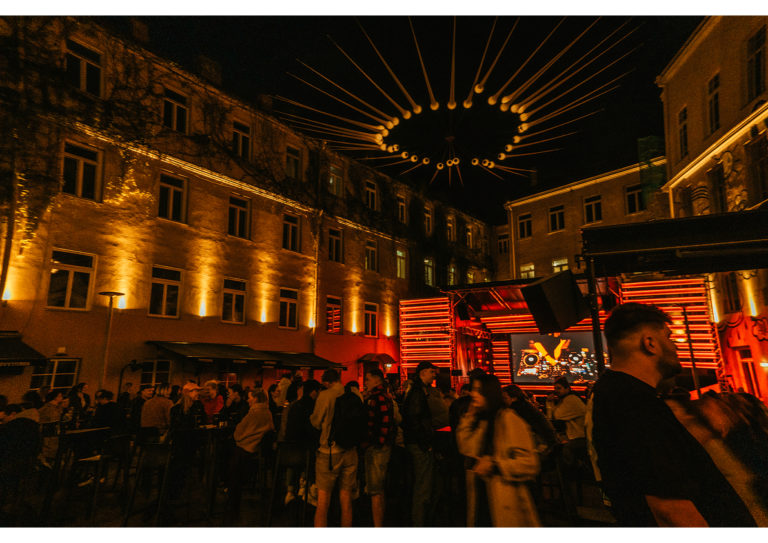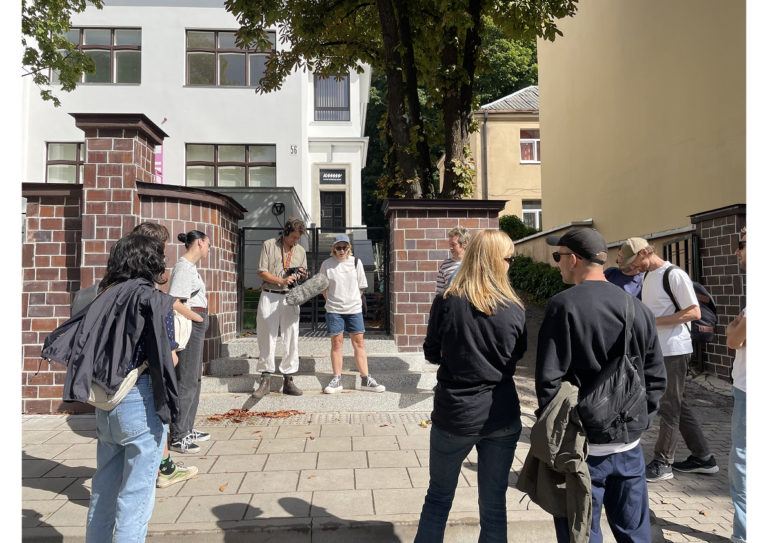Author: Manon Moulin
As Lithuania stands at a cultural crossroads, its artists, journalists, and musicians are taking to the streets—and the airwaves—to defend their artistic freedom. In a nationwide protest sparked by the controversial appointment of the Culture Minister, the country’s independent cultural and media scene has united with the institutions under the banner of Kultūros Asamblėja (“Cultural Assembly”). Their message, carried by the echoes of Čiurlionis’s The Sea, is clear: “This could be the last time” Lithuania’s free artistic spirit can resist the tide of political opportunism.

Protest in Vilnius, October 5th, 2025 – © Edvinas Girdvainis / NARA
October 5th, 2025. 2 pm. All over Lithuania and its diaspora. You could hear the powerful and brilliant symphonic poem Jūra (The Sea) by Mikalojus Konstantinas Čiurlionis, one of the most influential Lithuanian artists of the 19th and 20th centuries. This common resonance is not due to the 150th anniversary of Čiurlionis’s birth, but because the Lithuanian cultural and arts community is currently raising its voice against serious political threats. Their symbols are a road sign warning of nearby piers, altered to show the word kultūra (culture) sinking into the water, alongside Čiurlionis’s The Sea. Diving into Lithuania’s strong cultural movement, we uncover a worrying political situation that deserves attention to avoid going toward Hungary’s, Georgia’s, Slovakia’s, or Italy’s direction.
A Year of Political Slippery Slope
The current situation stems from the most recent parliamentary elections, which took place in October 2024. These elections saw the Social Democratic Party of Lithuania (LSDP) come out on top with just over 19% of the vote, meaning they had to form a coalition.
A new party, Nemunas Dawn (ND), also emerged, finishing third with almost 15% of the vote. Considered nationalist, pro-russian, and ‘populist’, the party is also strongly opportunistic, as explained by Karolis Vyšniauskas from NARA and Julius Praleika from minimal.lt. “This party doesn’t really stand for anything,” says Karolis. It is led by Remigijus Žemaitaitis, a millionaire who has made numerous antisemitic, transphobic, and anti-Ukrainian remarks, thereby violating his MP oath. These statements are particularly serious in a country that was under Soviet occupation for almost 50 years and is still threatened by russian imperialism, being surrounded by the Kaliningrad Oblast (part of russia) to the south-west and Belarus to the east. Lithuania has also been one of the main countries to welcome Ukrainian refugees and Belarusian dissidents.
With this new political player in mind, discussions to form a government were extremely sensitive and took months. The LSDP first confirmed that they would not form a coalition with Nemunas Dawn. After engaging in talks with the Lithuanian Farmers and Greens Union (LVŽS), the Union of Democrats ‘For Lithuania’ (DSVL), and the Liberal Movement (LS), they finally formed a first coalition with DSVL and Nemunas Dawn. This political reversal sparked serious discontent among Lithuanian civil society, which mobilised immediately through an open letter denouncing the potential negative impact that ND’s presence could have on Lithuanian democracy.
In July 2025, LSDP Prime Minister Paluckas resigned amid corruption allegations, further destabilising Lithuanian politics in recent years. As Julius Praleika presented, “This term has been very chaotic and riddled with corruption and conflicts of interest scandals, resulting in over a year without a properly established cabinet of ministers.”
In September, a new prime minister took office: the Social Democrat and former trade unionist Inga Ruginienė. This new government is based on a reshaped coalition made of LSDP, LVŽS, and still ND. While forming the government, tensions arose over which ministries to allocate to their coalition partner, Nemunas Dawn. Although they were supposed to receive the Agriculture and Energy portfolios, they lost the latter as the Social Democrats deemed it to be too strategically important, instead offering the Culture Ministry to Nemunas Dawn.
The party appointed businessman Ignotas Adomavičius as Culture Minister, despite him having no background or experience in the cultural field whatsoever. One week after his appointment, on October 3rd, 2025, he resigned under pressure from the October 5th strike within the cultural and media communities.

Protest in Vilnius, October 5th, 2025 – © Edvinas Girdvainis / NARA
Discredited Yet Strategic Culture, Arts, and Media
This ministry swap is a sign of the lack of consideration for culture in Lithuanian politics, as in many other European countries. As Julius puts it, “the post of Minister of Culture has always been a mere bargaining chip for majority parties forming a coalition,” and Indrė Kiršaitė from NARA adds that “culture receives one of the lowest budgets of all ministries and is often considered a low priority in Lithuania.” The discredit was made clear with the appointment of Adomavičius, as his glaring incompetence was evident, as Indrė explains.
Despite this obvious discredit, culture and the media—both under the remit of the Ministry of Culture in Lithuania—are typically exploited as strategic tools for manipulation and propaganda. Lithuania’s Soviet heritage exacerbates this issue: “They are well versed in how culture can be instrumentalised as a form of soft power and fall victim to pro-russian narratives,” says Samantha Lippett, who has been living in Lithuania for five years. So, in this situation with Nemunas Dawn, the threat is real.
Even before receiving the Culture Ministry’s portfolio, Nemunas Dawn’s leader Žemaitaitis made incendiary comments regarding the media. As reported by Indrė Kiršaitė and Samantha Lippett, he publicly stated his intention to call for ‘content audits’ of the public broadcaster LRT due to its alleged bias towards certain political parties. Access to the Culture Ministry would enable ND to carry out this threat and redirect public funding along ideological lines. This process has already begun, with the LRT audit due to be completed by November 3rd, 2025. When asked whether NARA is under pressure due to this shift, Indrė responds that, as an independent organisation, they have diversified their income sources, making them less dependent on national funding and enabling them to avoid direct pressure. Nevertheless, this doesn’t mean they are less linked to their fellow journalists from other media outlets that may be targeted, or to their cultural counterparts. “We are connected,” says Indrė Kiršaitė.
Nemunas Dawn has a limited vision of culture. They prioritise rural and ethnoculture, and believe that national funds should first support this kind of culture, making it a State priority. This aligns with their ethnonationalist views, as Indrė Kiršaitė points out. They believe that culture is currently oriented solely towards the ‘Vilnius elite’. By making such statements, ND is also attempting to divide the sector by setting traditional and regional culture apart from other types of culture and urban cultural players. These positions put the nightlife scene in a difficult position. “The nightlife scene could suffer serious damage if the new ministry accuses us of promoting drug use because of our open-minded stance on individual rights and our active role in harm reduction,” explains Julius Praleika, part of minimal.lt, which has been organising the Minimal Mondays event series since 2004, and Sūpynės Festival between 2006 and 2019. Their summer venue for Minimal Mondays is directly accountable to the Ministry of Culture, meaning “there is still a risk of political repression,” says Julius. As always, it is the grassroots and alternative players who are first targeted within the cultural sector. However, what is happening across Lithuania right now shows the true meaning of unity and solidarity.

Minimal Mondays at their summer venue Vasaros Terasa – © Goda Dagytė
A United Struggle
On October 5th, thousands of these individuals took to the streets under the banner of Kultūros Asamblėja (Cultural Assembly) and the slogan ‘This could be the last time,’ carrying their sinking kultūra road sign placards and accompanied by the sounds of Čiurlionis’s The Sea. “It was played on national radio, LRT, in the streets by a walking jazz band and by our symphony orchestra at the LVSO concert hall in Vilnius. It was also played on repeat in local bookshops,” says Samantha Lippett. Julius Praleika adds that “Čiurlionis’s incredible body of work across multiple fields of art is always worthy of celebration and serves as a great meeting point for artists and cultural workers from different disciplines.” Karolis agrees: “Listening to it in full on the protest day was a truly elevating experience.”
This massive and inspiring protest movement has spread throughout the country, with protests organised in big cities and regions, and even across the world with the diaspora mobilising. Samantha Lippett explains, “The scale and diversity of the organisations involved has been inspiring to observe. This has not only brought together like-minded independent organisations, but also united cultural actors from across creative fields, including opera houses, museums, bookshops, jazz bands, grassroots collectives, students and individuals, under the banner of the Kultūros Asamblėja. Both privately and publicly funded.” She also notes the participation of folk organisations and regional culture centres in the protests, which challenged the divide put forward by Nemunas Dawn. She adds that “this was one of the most powerful aspects of October 5th.”
This strong unity is also highlighted by Indrė Kiršaitė, Karolis Vyšniauskas, and Julius Praleika. Although Lithuanian cultural figures have been protesting since Soviet times, notably with the ‘Rock Marches’ concerts, where local bands openly stood up for independence in different cities across Lithuania, as Karolis evokes, this movement is unprecedented. “Artists and cultural workers who might never have met before are now marching and singing together,” says Julius. This goes beyond the cultural and media sectors, too. According to a recent LRT survey, 45% of the Lithuanian population support the protests, while 23% have no opinion, and 32% oppose them.

Kaunas Radio History Tour with Kotryna Lingienė during the ICRN gathering in Lithuania, August 2024 — © ICRN archives
These signs of unity and solidarity are encouraging for the future of Lithuanian culture and media. However, we must remain collectively vigilant until a new Culture Minister has been appointed. Following antisemitic remarks made by Nemunas Dawn Žemaitaitis against the Director General of the Lithuanian Museum of Art, who is a member of the protest movement, the President of the Republic of Lithuania Gitanas Nausėda said he would not be signing in a new ND minister, forcing the Social Democrats to search for a new minister by themselves. However, they have not historically been known for keeping their word or maintaining a respectable position. As Kultūros Asamblėja stated, ‘This could be the last time,’ but Lithuania’s culture and media players are ready to counter these dynamics, and we stand in solidarity with them.
References
"Žemaitaitis trans moterį prilygino arkliui" (Žemaitaitis compared a trans woman to a horse), GayLine, July 28th, 2023
"Lithuania Reshapes Its Political Landscape: A New Coalition of Populists and Social Democrats Takes Power," Chas Pravdy, August 25th, 2025
Austė Sargytė, "New government, new protests," LRT, August 29th, 2025
"Įspėjamajame kultūros streike M. K. Čiurlionio „Jūrą“ gyvai atliks trys orkestrai" (Three orchestras will perform M. K. Čiurlionis' "The Sea" live during the warning cultural strike), Kultūros asamblėja, October 3rd, 2025
"Lithuanian Culture Minister Ignotas Adomavičius Resigns Amid Controversy," Mezha, October 3rd, 2025
Katarzyna-Maria Skiba, "Lithuanian arts community protests controversial takeover of culture ministry," Euronews, October 5th, 2025
Helen Wright, "Protests across Lithuania against culture portfolio for populist party," October 5th, 2025
Edvardas Šumila, "It May Be the Last Time: Lithuanian Art and Culture Resisting a Takeover at the Height of Hybrid Warfare," e-flux, October 6th, 2025
Jurga Bakaitė, "Almost half of people in Lithuania support protests against Nemunas Dawn – poll," LRT, October 10th, 2025
"Žemaitaitis sparks outcry with antisemitic remarks targeting National Art Museum head," LRT, October 10th, 2025
"Lithuanian cultural community wows to continue protests over culture ministry dispute," LRT, October 15th, 2025
Published on October 23rd, 2025
About the author:
Manon Moulin is the editorial coordinator of all European projects for the non-profit organisation Arty Farty. She specifically works on the European network of independent cultural and media organisations Reset!.